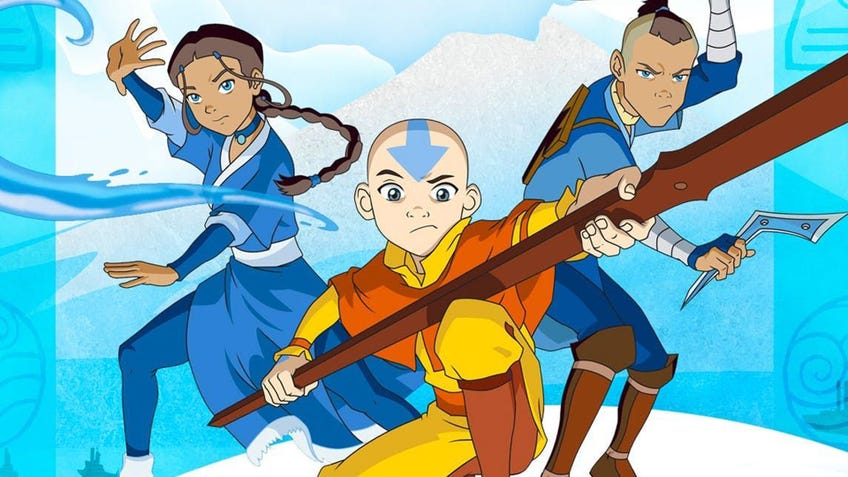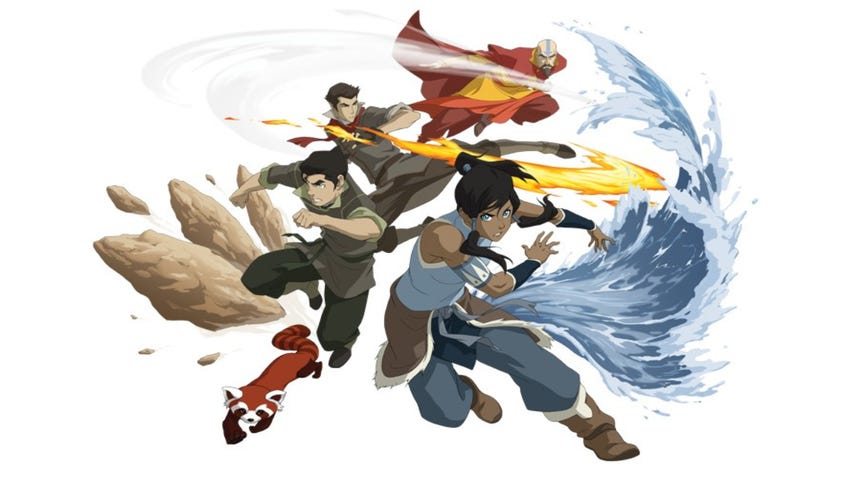Avatar: The Last Airbender RPG first details: five playable eras, keeping Balance and how bending will work
Flameo, hotpeople!
Mark Truman, CEO of Magpie Games, feels like the last decade of the studio’s work has all led to the team working on an Avatar: The Last Airbender RPG. The studio recently announced it had secured the licence from Viacom CBS to develop the world of Avatar and its sequel series Legend of Korra into a tabletop setting, with a sourcebook dropping in 2022.
Truman and lead designer James Mendez Hodes spoke with Dicebreaker about the current design process - much of it still not written in stone - and why Powered by the Apocalypse felt like the right platform upon which to build their game. Mendez, along with several other designers of colour and indigeneity, has been working alongside Magpie on writing, design and cultural consultancy.
We want bringing in those influences to be a source of joy and confidence.
“Mark contacted me back in September and said, ‘We got this licence property, we know you're gonna want to work on it. We can't say what it is,’” Mendez said. “So, I was convinced for a couple of months that Mark had gotten the licence to make a roleplaying game about the Wu-Tang Clan.”
Mendez quickly recovered from the initial disappointment of not designing Method Man or Raekwon playbooks when he heard the details. Along with past title Thousand Arrows and consultancy work on Jiāngshī: Blood in the Banquet Hall, he had previously worked with Magpie on a number of projects and supplements. His experience in tabletop games and martial arts had landed Mendez on Truman’s shortlist.
“It was this numinous feeling, like some deity had reached down and grabbed me by the lapels and was like, ‘That thing, that game that you've always wanted to make that since you started gaming? And since you started watching television? Yeah, it's finally happening,’” Mendez said.
Magpie’s 10-year history mirrors some of the larger shifts in the tabletop design space. The company began around the same time as crowdfunding platform Kickstarter, which Truman and other members of the team still use as a way to fund their projects and draw feedback from fans. They also adopted D. Vincent and Meguey Baker’s Apocalypse World as a foundation for some of their first breakout titles, giving them an intimate familiarity with a game that would shape the studio’s design philosophy for the next decade.
As it turns out, it would also be the perfect fit for adapting Avatar from a beloved kid’s television series to an RPG system. “We knew right from day one that Powered by the Apocalypse was what we wanted to do with this product,” Truman said. Magpie used Masks: A New Generation as a working prototype, realising the themes of self-discovery and understanding the morality of power at the core of the young superhero RPG shared a lot of DNA with Avatar.
They also felt PbtA’s playbooks gave them the space to explore what it means to live in a world of colonisation and systemic oppression, but also one of shared culture and values. Both Truman and Mendez emphasised the importance of their RPG getting this right.
Ultimately, these settings are about people who are making tough choices because they value many things, not just winning a fight.
Mendez says the question he gets asked the most is how to play an Asian character without tripping headlong into stereotypes and derivative pitfalls. Aang and Korra’s world is one of pastiche and homage, drawing from the language, architecture, art and philosophy of several East Asian countries in both stark contrast and interesting blends. By focusing the playbooks on a lived experience versus some innate characteristic like race or heritage, they want players to begin character creation on the right foot.
“If you can write that cultural content into the playbook in a way, such that interfacing with the playbook is all that the player has to worry about, then all you have to tell them about how to play an Asian character is: ‘Don't worry about it, just play a character. And the game will supply everything that you need,’” Mendez said.
The sourcebook will also contain resources to guide both GMs and players towards tasteful appreciation of the Avatar world’s influences, especially if Asian or Asian-American players join them at the table. For Filipino-American Mendez, this is a critical issue and one he feels confident their book will address well.

“I always tell people you have to be really careful about taking a lot of people's time and emotional energy. They don't necessarily want to pour out all of their, you know, deep secrets about cultural issues. For them, that might be really touchy and sensitive,” he said. “One thing that we definitely want to do is to guide players in terms of how to do that research and how to bring in real-world Asian influences in a respectful and validating way. We want bringing in those influences to be a source of joy and confidence.”
The lack of a distinctly defined ‘White’ people eases this work somewhat, both Truman and Mendez admitted. RPGs that clumsily weave in Asian influences often end up having one character stand in as a cultural monolith, whether as “a magical, mystical, Dragon-themed villain or the one good guy who knows karate,” according to Mendez. Every poem and song, ideal and philosophy, clothing and custom belongs to the Avatar world and all of its inhabitants instead of some grand, tourist trip.
The other huge concern for the team was, of course, the bending. People in the Avatar universe can manifest the ability to manipulate the four basic elements that compose the world - fire, water, earth and air - and are referred to as benders. In the show, this power is tied to specific countries and their history and is layered in meaning and social importance. It’s also used as a weapon and tool, and that dual social/combat utility has proven a challenge to design in a satisfying way.
We think that gives you the ability to choose one of the spaces that you think is going to have the most excitement and the most conflicts that are right for your group.
Truman admitted it would be easy to clearly define the rules of bending in the terms of crunchier systems such as Dungeons & Dragons or Burning Wheel, but that betrays the ubiquity of bending’s potential. When players create their characters, certain bending types will not be restricted - they will instead drill down into how well that character can bend their preferred element.
“This idea of competence and training - we really want to emphasise that a firebender doesn't have to roll dice every time they bend fire. We want to emphasise that somebody who's great with technology in Republic City is not rolling dice to turn on a Satomobile,” Truman said.
Bending in Magpie’s RPG will not be defined by how many feet in a cone a bender can push air or how many hit points a thrown rock does in terms of damage. To the team, that felt too boring and limiting. Players will make a conscious choice as the campaign advances to deepen their understanding of bending or to go a different route - become an adept politician or strengthen the personal relationships within the group. Of course, there will be clear paths for players to realise their dream of becoming the most powerful firebender in existence, if they so choose.
The design team understands that the visuals of bending are also important. The show famously worked with Sifu Kisu to represent real-world martial arts in the body movements of different benders. Mendez said including those details are wonderful if the table is comfortable with that level of detail, but they don’t want that knowledge to be a barrier to enjoying the game for newcomers or those lacking the vocabulary to describe the many possible forms.
The game will instead allow characters to personalise their bending forms to match their personality. The precedent for such has existed in the show since its inception, and Magpie feels giving players fiat in choosing how to represent something tied to their character’s core identity is never a wrong design move.
An additional mechanic Mendez is proud of is Balance, a measure of how closely a character is following the themes of their playbook. While they couldn’t offer too many concrete details, roleplaying in the Avatar world will pull characters in different moral and ethical directions, and the critical decisions they make - large and small - will affect that Balance.
We really want to emphasise that a firebender doesn't have to roll dice every time they bend fire.
When beginning a campaign, the table will be able to choose from among five different time periods in the Avatar universe as the setting for their adventures, each centred on the life of a particular avatar. Avatar Kyoshi and Roku encompass eras that had already passed into history and legend by the time of the original show. Avatar Aang’s era comprises all of The Last Airbender’s events and Aang’s life afterwards. Korra’s period takes place during the second television series and explores how the quickly modernising world is shaped by her actions.
The obvious outlier will allow groups to experience a world during Aang’s imprisonment in the ice and the ensuing 100-Year War era. The Fire Nation attacked, everything changed, but the stage of the original series hasn’t yet been set.
“We are committed to a very broad view of what it means to be in this world,” Truman said. “And we think that gives you the ability to choose one of the spaces that you think is going to have the most excitement and the most conflicts that are right for your group.”
Fans can expect all of the smaller details of the universe to also make appearances, from the chimeric animal hybrids and cabbage vendors to the ability to introduce canon characters into campaigns. Magpie is less keen on hard-coding that last point but understand certain groups might want to brush shoulders with greatness. They didn’t go so far as to introduce an Avatar playbook - some things remain untouchable.

Ultimately, Truman and Mendez expressed hope in preserving the emotional tenets of the series and its expanded universe of books and comics - growing up in wartime, learning the responsibilities of power, colonialism and its damaging legacy, and the importance of empathy in personal relationships. They want their game to empower players to ask the same important questions first posed by the show, along with providing satisfying narrative tools to seek their own answers.
“That’s the reason we're so excited about Powered by the Apocalypse as an engine for games like Avatar. Ultimately, these settings are about people who are making tough choices because they value many things, not just winning a fight,” Truman said. “But in fact, what are the costs of the fight? Who does the fight hurt? Who is saved? And who is not? Who is hurt? And who is not? And, and more importantly, what does it look like for all of this fighting to be done?”
The Avatar and Legend of Korra RPG’s core book is currently scheduled to release in February 2022, with two supplements - Republic City and The Spirit World - to follow in August 2022 and February 2023, respectively.
Edit: This story has been updated to accurately reflect James Mendez' surname.



